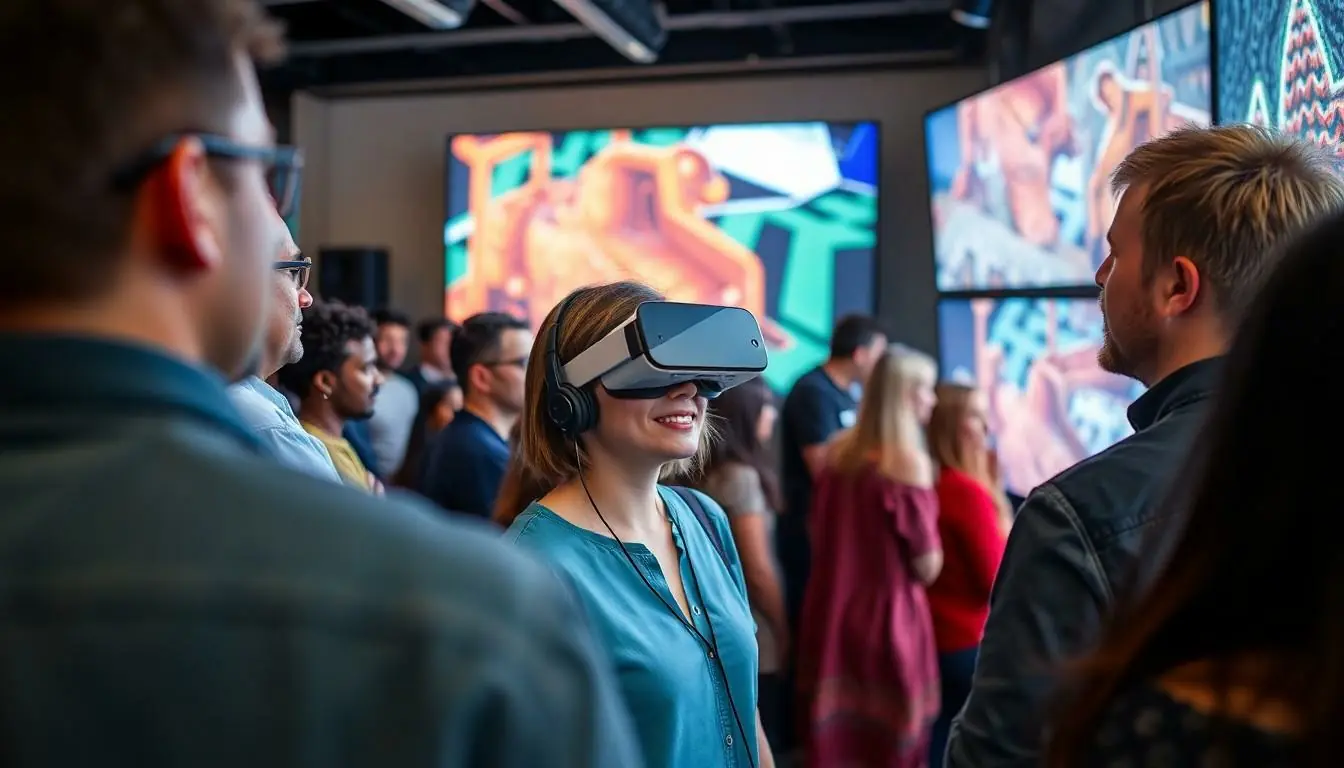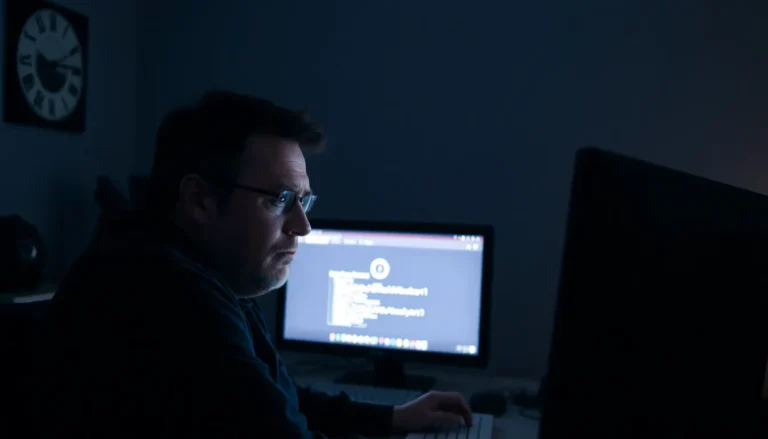Table of Contents
ToggleIn a world where every cat video and TikTok dance challenge seems to go viral, art audio/video technology isn’t just a luxury—it’s a necessity. Imagine transforming mundane communication into captivating experiences that leave audiences in awe. Whether it’s a slick presentation or an immersive art installation, the right tech can turn heads and spark conversations.
Overview of Art Audio/Video Technology and Communication
Art audio/video technology plays a pivotal role in enhancing communication within the digital landscape. This technology transforms mundane presentations into captivating experiences that genuinely engage audiences. Through various mediums, users can create immersive environments that capture attention and stimulate conversation.
Video installations often incorporate high-definition displays, ensuring clarity and richness in content. Engaging visuals combined with audio elements invite viewers to participate actively, rather than passively consuming information. Professional sound systems strengthen the emotional impact of presentations, keeping the audience’s interest glued to the content.
Art audio/video technology extends beyond traditional boundaries. Interactive elements, such as touch sensors and virtual reality components, empower viewers to influence their experience. These technologies foster a sense of ownership and involvement, crucial for meaningful dialogue.
Visual storytelling emerges as a vital aspect in modern communication. By blending art with technology, creators can convey complex narratives succinctly, making information accessible and relatable. Graphic design and animation enrich the audience’s understanding while elevating the overall impact of the message.
Art audio/video technology transforms communication strategies. Engaging content, immersive environments, and interactive experiences create significant connections between creators and audiences. This evolution highlights the necessity of adopting innovative tools to enhance artistic expression and effective communication in today’s world.
Historical Development

Art audio/video technology has evolved significantly, shaping communication over the decades. This evolution reflects innovations that enhance artistic expression and audience engagement.
Early Innovations
The invention of film in the late 19th century marked a turning point in art audio/video technology. Silent films captivated audiences, leading to the integration of sound in the early 20th century. The introduction of sound synchronized with motion pictures revolutionized cinematic experiences. Moreover, early experiments with recorded audio laid the groundwork for future technologies, making it possible to combine music, narration, and visuals seamlessly. Pioneers like Thomas Edison and the Lumière brothers played crucial roles in establishing these foundational elements, leading to a greater appreciation for audiovisual storytelling.
Contemporary Advances
Today’s landscape of art audio/video technology features sophisticated tools and techniques. High-definition displays and advanced sound systems dominate modern venues, creating immersive experiences. Interactive technology like augmented reality and virtual reality increasingly engages viewers, allowing participation in unique ways. Creators use software to blend different media forms, streamlining the production of compelling narratives. Furthermore, platforms for sharing content have expanded, giving artists global reach and easier access to diverse audiences. Innovations continue to shape how art is experienced, presenting endless possibilities for communication.
Impact on Artistic Expression
Art audio/video technology significantly transforms artistic practices. Artists leverage these tools to push boundaries, expanding what creativity can achieve.
Expanding Creative Possibilities
Integrating technology into art broadens creative possibilities. High-quality visual and audio elements allow for immersive installations that invite audience interaction. Artists can experiment with virtual reality, enabling viewers to step inside their creations. Additionally, digital platforms facilitate collaboration across geographic boundaries, fostering innovative ideas. Interactive components further engage audiences, as individuals shape their experience, making art more personal. Through these advancements, creators utilize technology to not only enhance aesthetic appeal but also deepen emotional connections with their work.
Case Studies in Artworks
Numerous artworks illustrate the impact of art audio/video technology. For instance, the installation “The Obliteration Room” by Yayoi Kusama employs projection mapping to encourage viewer participation. Visitors fill a white room with colorful dot stickers, transforming the environment over time. Another example is “Audiovisual Symphony” by Ryoji Ikeda, showcasing minimalistic visuals paired with soundscapes. This piece immerses the audience, demonstrating the power of synchronized audio and visuals. Each case exemplifies how art audio/video technology enriches artistic expression, enabling creators to tell compelling stories while engaging audiences in unprecedented ways.
Technical Aspects
Art audio/video technology relies heavily on advanced equipment and tools to create captivating experiences and enhance communication. This section details the essential components that contribute to immersive presentations and installations.
Equipment and Tools
Professional-grade equipment forms the backbone of art audio/video technology. High-definition cameras capture stunning visuals, while projectors display vibrant images on various surfaces. Sound systems featuring surround sound capabilities ensure crystal-clear audio, enveloping audiences in the experience. Lighting equipment helps set the mood, influencing emotional responses and engagement levels. Interactive components, such as motion sensors and touchscreens, create adaptive experiences, allowing audiences to interact directly with the art. Together, these tools elevate ordinary presentations into extraordinary interactions.
Software and Platforms
Software plays a vital role in shaping modern artistic expression. Various editing programs enable creators to fine-tune audio and visual elements for maximum impact. Platforms like Adobe Creative Suite and Final Cut Pro offer robust features for professionals. Additionally, content management systems streamline sharing and collaboration, enabling artists to reach broader audiences. Virtual reality software provides immersive environments where audiences can experience artwork in innovative ways. These technological solutions enhance the storytelling potential of art, fostering deeper connections and removing barriers between artists and viewers.
Challenges and Considerations
Art audio/video technology introduces several challenges that warrant careful consideration. Ethical implications arise primarily from content creation and distribution. Artists often navigate the complexities of copyright, ensuring they respect intellectual property while pushing creative boundaries. Questions around privacy also emerge when utilizing interactive technologies, as audiences may not fully understand data collection practices.
Accessibility issues frequently challenge artists and technologists. Not all audiences can experience immersive environments equally. Providing subtitles, audio descriptions, and alternative formats remains essential in creating inclusive experiences. Technological barriers can prevent some individuals from accessing content, highlighting the need for universal design in art installations. Engaging with diverse communities can lead to innovative solutions that enhance accessibility in art audio/video practices.
Future Trends
Rapid developments in art audio/video technology shape the future of communication. Innovations emerge regularly, enhancing how creators connect with audiences.
Emerging Technologies
Artificial intelligence plays a crucial role in transforming content creation. With AI-driven tools, artists generate immersive experiences more efficiently. Virtual reality continues to expand, offering deeper engagement through lifelike simulations. Augmented reality applications allow viewers to interact with digital elements in real space. Additionally, advancements in 3D audio significantly enhance auditory experiences, making sound feel more spatial and immersive. Integrated platforms that combine multiple technologies streamline the production process, enabling collaborative efforts across geographic boundaries.
Predictions for the Industry
Experts anticipate a shift toward more personalized experiences in art audio/video communication. As artificial intelligence capabilities grow, content will adapt more effectively to audience preferences. Increased accessibility through virtual platforms will democratize art, reaching wider audiences regardless of physical location. Additionally, continuous enhancements in hardware will facilitate more sophisticated installations, allowing for richer storytelling. Sustainability will become a priority, driving innovations focused on eco-friendly materials and practices. Furthermore, interdisciplinary collaborations will flourish, blending technology and creativity in new, unexpected ways.
Art audio/video technology is reshaping communication in profound ways. By merging artistic expression with cutting-edge tools, creators are crafting experiences that resonate deeply with audiences. The evolution of this technology fosters not just engagement but also meaningful interactions that transcend traditional boundaries.
As artists continue to explore innovative methods, the potential for immersive storytelling grows exponentially. The integration of interactivity and advanced audiovisual elements invites viewers to participate actively, enhancing their connection to the art. This dynamic landscape promises exciting developments, pushing the limits of creativity and communication further than ever before.






